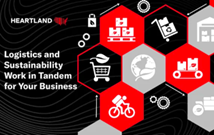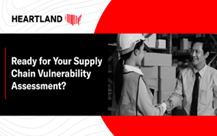
Who’s Driving the Supply Chain Sustainability Push?
Mar 07, 2024
Supply chain visibility solutions are being sought after more and more within our ever-modernizing society. With that said, however; sustainable supply chain management is not just some simple goal that a business can achieve through a certain set of practices. In fact, it is as intricate as the supply chain itself. Businesses that are devoted to obtaining sustainability within their supply chain should contemplate utilizing advancing global policies and ascending technologies in their evaluation of the supply chain, as well as their improvement initiatives, too. More often than not, sustainable supply chain trends will zero in on enhancing agility and resiliency, diminishing carbon emission throughout the supply chain, and entrusting technology to improve transparency.
In addition to that, transparency is one of the largest trends and perhaps the most important component of a sustainable supply chain management system. At its initial phase, transparency starts with supply chain visibility. However, it is defined by how a business utilizes insights into visibility to take action and administer risk more efficiently. It requires a deep level of understanding of both downstream effects of distribution and customer assurance and upstream activities of manufacturers and suppliers. Not only does transparency grant data to enhance supply chain resiliency, but it also aids sustainable supply chain practices in acknowledging issues like waste and emissions. Of course, in our contemporary age, technology plays a crucial role in transparency. So much so, it allows businesses to see data from both internal and external sources for an expanded view of risks and participants in the supply chain, while enabling clear and concise communication between all involved parties. For the most part, this level of insight is obtained through the development of digital twins—which serve as virtual replicas of a business’ supply chain. In this replication, digital twins collect data in real-time from multiple visibility technologies in order to map out suppliers, origins of materials, logistics, and warehouses. In doing so, it analyzes the dynamics of the supply chain and acknowledges possible risks to sustainability. Not only that, but digital twins also allow businesses to predict future challenges, rapidly react to interruptions, and help label weak points within their sustainable supply chain—such as providers or vendors that are not aligned with the business’ broader goals, for example. At Heartland, our solutions are to apprise resilience efforts within the supply chain as well as long-term initiatives for sustainability.
3 Drivers of the Supply Chain Sustainability Push
- Growing Consumer Demand – Now more than ever, consumers are progressively growing more mindful of what their products are made of, where they come from, and the methods in which they are produced. So much so, more and more people are taking into account how their purchasing habits affect the world, as a whole, and are searching for zero waste, eco-friendly brands and products that are aligned with their values regarding sustainability. Of course, this goes far beyond simply switching from brand to brand. In fact, to support sustainable procedures, many consumers are resolutely and blatantly boycotting businesses that do not meet fair labor or environmental standards. In today’s relentlessly moving age of social media prominence, things like boycotts and talk of unfair procedures spread like wildfire and can critically impact a business’ reputation and profitability.
Related: How to Master Accurate Demand Forecasting
- Pressure From Investors – As the demand for sustainable supply chain procedures from consumers continues to increase, the same pace of increase lives in the demand from investors as well. This reflects the ongoing rise of sustainable investing, also known as ESG investing or socially responsible investing. This type of investing spotlights the reality of more investors wanting to consider the environmental, social, and governance (ESG) factors of their financial contributions. Generally, sustainable investing constructs decisions off more than just the financial success of a business. In fact, this kind of investing considers their social capital and devotion to positive change. More likely than not, ESG investing is going to expand in the coming years, as more millennials are beginning to enter the investment market. Because of that, sustainability within the supply chain is becoming progressively more important for businesses of all kinds.
Related: How Sustainability and Logistics Thrive Together
- Internal Sustainability Drives – Of course, the prevalence of the external drivers of supply chain sustainability is clear for all to see—such as the previously mentioned consumer and investor demands, respectively. Along with those, there are many internal factors that can also motivate businesses to integrate enhanced sustainability procedures. Pursuing supply chain sustainability is much more than a publicity stunt, marketing tactic, or buzzword. Its benefits are expansive and very real—as they appease businesses and their consumers, as well as the planet and our society within it. At its core, sustainable supply chain management assists in the improvement of productivity and optimizes costs, so that a business benefits from these pushes for sustainability in many ways:
- Constant improvement in the supply chain through consistent sustainability assessments.
- Enhanced business partnerships through shared beliefs and initiatives.
- Collective work cultures through common visions and goals.
- Improved risk mitigation within the supply chain and contingency planning.
- Augmented perception of brand and customer opinion.
Related: Is it Time to Perform a Supply Chain Vulnerability Assessment?
When pursuing a sustainable supply chain, it is important to start by improving overall visibility. Ultimately, it is difficult to label goals in sustainability without a definite understanding of how and where the supply chain is affecting the environmental, social, and economic sectors. As businesses continually take steps toward implementing sustainable procedures within clear-to-see points of their supply chains, recognizing inconspicuous problems becomes pivotal in managing momentum and making consistent improvements. Real-time visibility over location and condition provides data on in-transit shipments to maintain sustainable supply chain procedures. In fact, real-time tracking of shipments is vital to supply chain teams for countless reasons. Most of all, it applies to approaching purchase orders to refresh inventory and materials or the delivery of shipped customer orders. With that said, tracking of shipments has much more to offer for visibility over sustainability procedures as well. Real-time visibility over shipment location and condition provides invaluable data that can be used to enhance supply chain transparency and diminish carbon emissions.
Transparency over the supply chain requires visibility into the processes of suppliers and distribution. Luckily, real-time visibility offers data for both instances. By watching over the movements of shipments from suppliers, businesses can evaluate environmental procedures and transportation effectiveness to guarantee that upstream partners are aligned with their sustainability goals. Additionally, downstream visibility over shipments provides insight directly into carbon emissions and grants updates that are needed to effectively manage businesses. Real-time tracking of location assists environmental and economic sustainability efforts.
Of the many drivers behind the supply chain sustainability push, Heartland is adept at working with them all. At Heartland, our expert solutions are skillfully designed to be scalable and sustainable for multiple realms within the supply chain. If you are interested in adding your business to the push for sustainable supply chains, reach out to our team today.





